
Sorry to break it to you, but your mobile device has a bull’s eye on it! Researchers are devising ways to hack into your device using hardware that is easy to mistake as legitimate. Imagine that you are at the home of an acquaintance, when your phone suddenly runs out of batteries. That spare charger your acquaintance gives you to charge your device could be a tool for injecting malware on your phone. Increasingly clever hacks that take advantage of our trust in others have create opportunities for hackers to steal the personal information we keep on our devices.
Software that tracks our device from remote locations can help us recover a lost phone, but that’s only the beginning of security measures that should become standard to anyone with a smartphone.
Recovery
Applications like “Prey” put a tracking system on your device. It uses geo-location and Wi-Fi positioning to locate your phone and provide remote functions like shutting it down or wiping the device. You can also program the device to take a picture of the thief. Samsung and Apple each offer similar services of their own through security pages you can access once you have your device connected to the network.
Just like a computer, network security protection is important to mobile users. Apps that watch your browsing habits in real-time and inspect files for integrity will keep your device safe from malware designed to leech your information.
Safe Downloads
The inherent open nature of the Android marketplace also represents a huge risk to the uninformed user. For many reading this article, safe downloads seem second nature, but we don’t often assess the qualities of a safe download. Sure, you know them when you see them. What do they look like?
• A safe download comes from the source URL. It does not come from a third party, unless the file is hosted elsewhere.
• Safe mobile downloads usually come from the Play or App store. The developer is often reputable, and there are multiple reviews written by actual users. Reputable apps are often rated higher than three stars, but reviews fluctuate depending on the quality of a release. Especially on Android.
Keep it With You
When you get up to use the restroom, do you take your phone with you? Many people do, but the few that don’t risk physical theft of their device. Aside from potentially embarrassing data, like texts or photos, your phone contains passwords to your bank accounts and access to your email. This data can be used to spoof your accounts, or send messages on your behalf or using your information. These spoofed emails present a serious security risk to you. The simplest solution is to just take your device with you.
Password Protection
Get in the habit of password protecting everything you own. Your computer should have a long password that is easy to remember. I prefer to use short pass phrases that I can recall (usually quirky things) but you can use whatever method works best for you. Also, invest in a password management app. There are a variety of free solutions with premium upgrades designed to share passwords with team members if you ever need to bring passwords to work with you.
Using Bank Applications
Chase bank requires authentication when it detects a new device. From then on, your password and username get you into the application. If someone does steal your device, how long will it take to figure out your password? If you’re like most people, your password is the same for all applications and devices as well, making you an easy target.
Having a complicated password helps, but train your phone to forget things like your login credentials and your user ID. It saves you in the event of theft.
Related Posts
Posted in: Lifestyle
Tags: mobile, mobile devices, mobile phones





